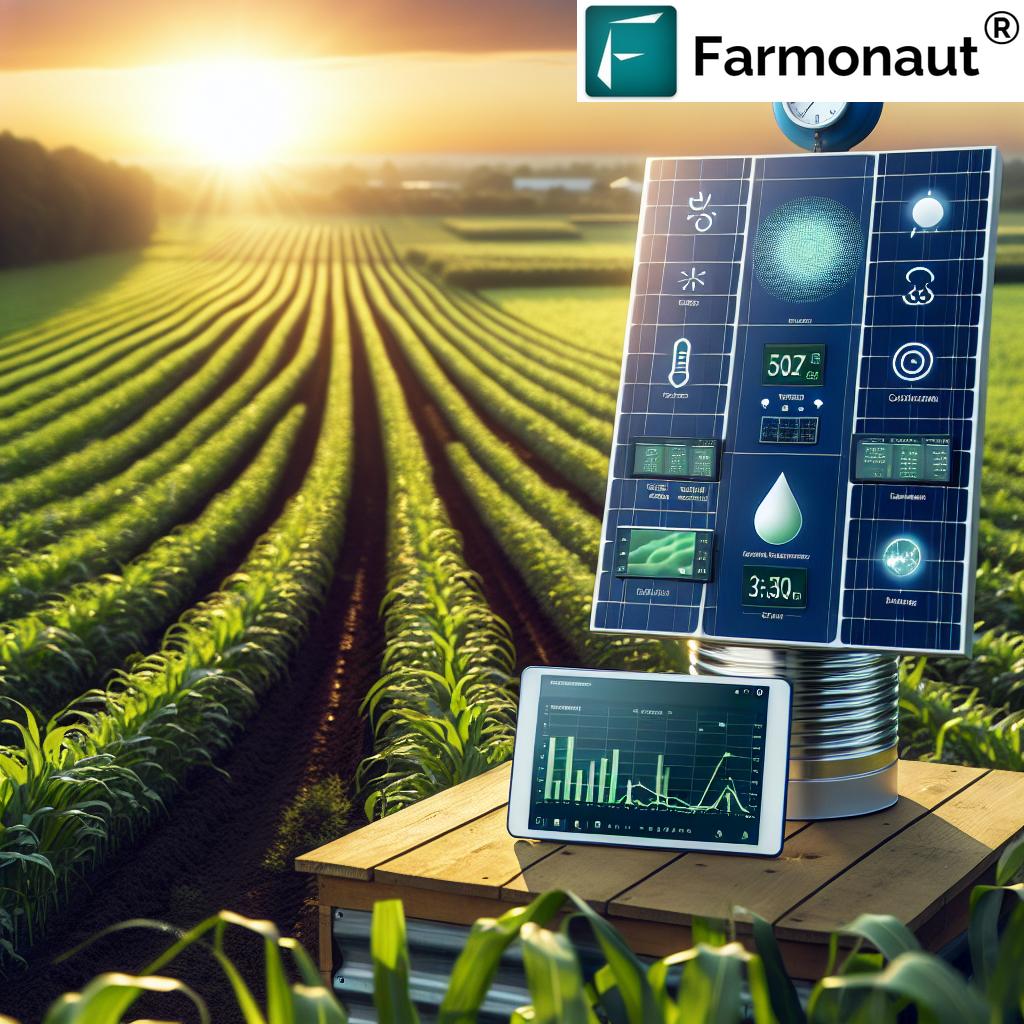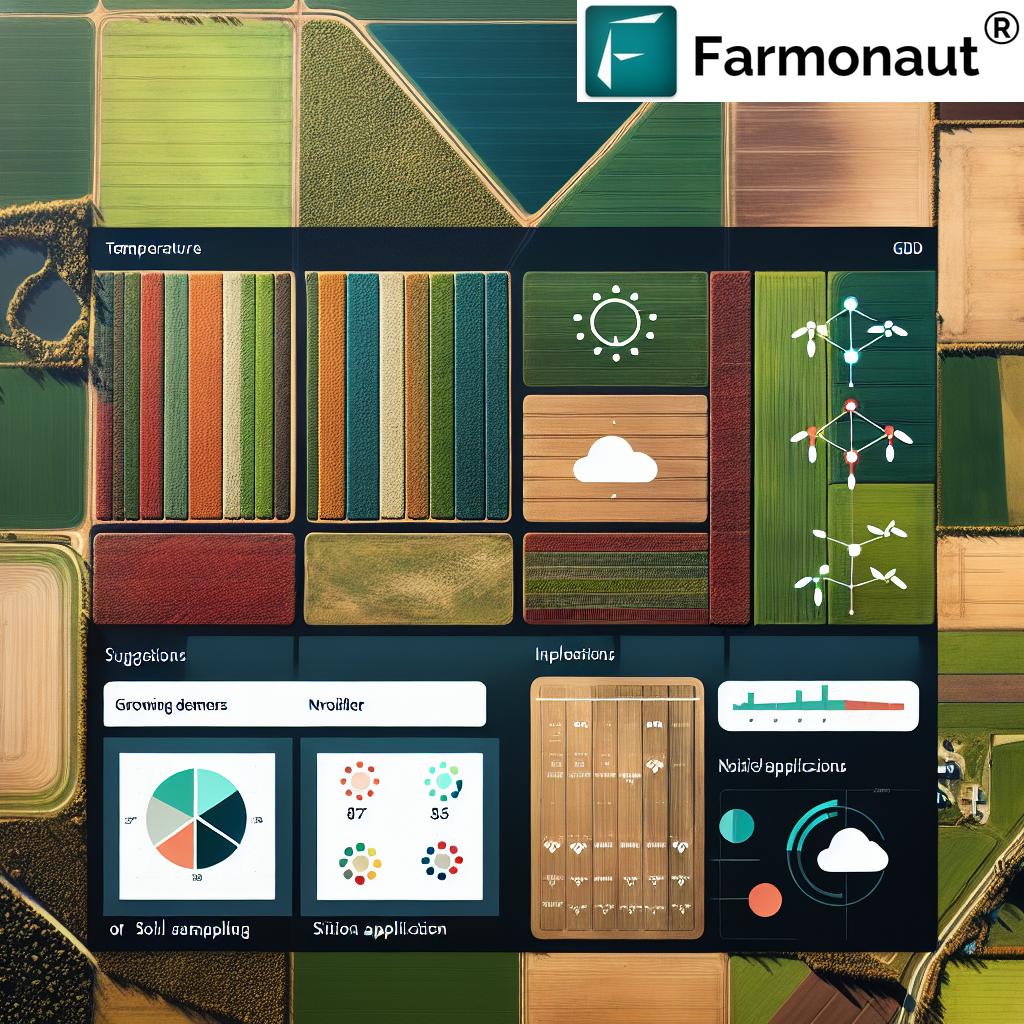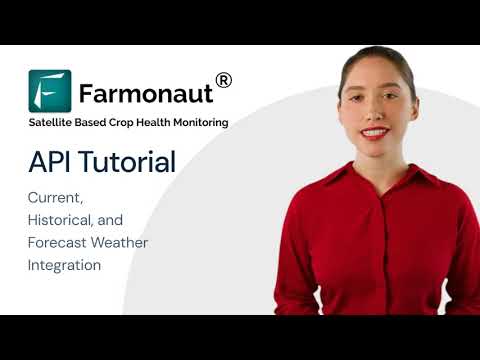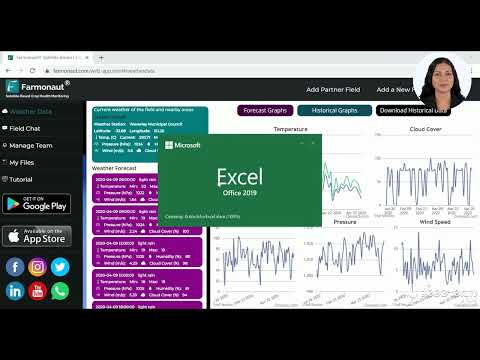Revolutionizing Precision Agriculture: How On-Farm Weather Stations Drive Smarter Crop Management
“On-farm weather stations can detect temperature variations of up to 5°F between nearby fields, significantly impacting crop growth predictions.”
In the ever-evolving landscape of agriculture, precision agriculture technology is revolutionizing the way we approach crop management. At the heart of this transformation lies a powerful tool: on-farm weather stations. These innovative devices are not just changing the game; they’re redefining it entirely. In this comprehensive exploration, we’ll delve into how localized weather information is becoming the cornerstone of optimized crop production, and why it’s crucial for modern farmers to embrace this technology.

As we navigate through this topic, we’ll uncover the critical role that field-specific weather data plays in modern farming practices. We’ll explore how seemingly minor temperature variations across nearby fields can have significant impacts on Growing Degree Days (GDD) calculations, ultimately affecting crop growth predictions and development forecasting. Moreover, we’ll discuss why relying on regional weather data from urban areas or airports may not accurately represent the conditions in your agricultural fields.
The Power of Localized Weather Data
In the realm of precision agriculture, knowledge is power, and localized weather data is the key to unlocking that power. Here’s why:
- Microclimate Awareness: Every field has its own microclimate, influenced by factors such as topography, soil type, and surrounding vegetation.
- Precise Decision-Making: Field-specific data allows for more accurate predictions and timely interventions in crop management.
- Resource Optimization: Understanding local conditions helps in efficient use of water, fertilizers, and pesticides.
- Risk Mitigation: Early warning systems based on local data can help farmers prepare for adverse weather events.
At Farmonaut, we emphasize the importance of field-centric data collection for accurate agricultural results. Our smart farming solutions are designed to leverage the power of localized weather information, providing farmers with the tools they need to make informed decisions.
The Network of Knowledge: On-Farm Weather Stations
Imagine having a network of sentinels across your fields, constantly monitoring and reporting on the most crucial environmental factors affecting your crops. That’s exactly what a network of on-farm weather stations provides. These stations are the eyes and ears of modern agriculture, offering farmers unprecedented access to crucial information on:
- Temperature fluctuations
- Rainfall patterns
- Humidity levels
- Wind conditions
This wealth of data empowers growers to make informed decisions about various aspects of crop management, including:
- Soil sampling strategies
- Nitrogen recommendations
- Crop protection measures
By harnessing the power of agricultural weather monitoring, farmers can enhance their farm’s productivity and sustainability, paving the way for a more efficient and environmentally conscious approach to agriculture.
Growing Degree Days: The Pulse of Crop Development
One of the most significant applications of field-specific weather data is in the calculation of Growing Degree Days (GDD). GDD is a measure of heat accumulation used to predict plant and pest development rates. Here’s why accurate GDD calculations are crucial:
- Precise Growth Predictions: GDD helps farmers predict when their crops will reach various growth stages, from emergence to maturity.
- Optimal Timing: Understanding GDD allows for better timing of planting, fertilization, and harvest.
- Pest Management: GDD can predict the development and emergence of pests, allowing for targeted control measures.
However, the accuracy of GDD calculations hinges on the precision of temperature data. This is where on-farm weather stations shine, providing field-specific temperature readings that can significantly differ from regional data.
The Pitfalls of Regional Weather Data
While regional weather data from urban areas or airports has been the go-to source for many farmers, it comes with several limitations:
- Lack of Specificity: Regional data fails to capture the unique microclimates of individual fields.
- Urban Heat Island Effect: Data from urban areas may be skewed due to the heat-retaining properties of cities.
- Elevation Differences: Airports are often at different elevations than farmlands, leading to temperature discrepancies.
- Distance Inaccuracies: The further a field is from the weather station, the less accurate the data becomes.
These limitations underscore the importance of field-centric data collection for precise agricultural decision-making.

Farmonaut: Bridging the Data Gap
At Farmonaut, we understand the critical need for accurate, field-specific weather data. Our smart farming solutions are designed to bridge the gap between traditional weather monitoring and the specific needs of modern agriculture. Here’s how we’re making a difference:
- Satellite-Based Monitoring: We utilize advanced satellite technology to provide real-time crop health monitoring.
- AI-Driven Insights: Our Jeevn AI advisory system analyzes multiple data points to deliver personalized farm management strategies.
- Integrated Weather Data: We offer seamless integration of weather data into our platform, allowing for comprehensive farm management.
By leveraging these technologies, we enable farmers to make data-driven decisions that optimize crop yields and resource management.
“A network of 10 strategically placed weather stations can provide 90% more accurate field-specific data than regional weather reports.”
The Impact of Weather-Based Crop Management
Implementing weather-based crop management strategies can lead to significant improvements in various aspects of farming:
- Irrigation Efficiency: Precise rainfall data allows for optimized irrigation schedules, reducing water waste.
- Fertilizer Application: Understanding soil moisture and temperature helps in determining the best times for fertilizer application.
- Pest and Disease Management: Weather conditions play a crucial role in pest and disease development. Accurate data helps in predicting and managing these issues.
- Harvest Timing: Weather forecasts and accumulated GDD data can help determine the optimal harvest time for maximum yield and quality.
By leveraging these strategies, farmers can not only increase their yields but also reduce their environmental impact and operational costs.
The Future of Precision Agriculture
As we look to the future, the role of on-farm weather stations in precision agriculture is only set to grow. Here are some trends we’re watching:
- IoT Integration: Weather stations will become part of a larger Internet of Things (IoT) ecosystem on farms.
- Machine Learning: Advanced algorithms will provide even more accurate predictions and recommendations based on historical and real-time data.
- Climate Change Adaptation: Localized weather data will be crucial in helping farmers adapt to changing climate patterns.
- Automated Decision-Making: Integration with farm machinery could lead to automated adjustments based on real-time weather conditions.
At Farmonaut, we’re committed to staying at the forefront of these technological advancements, ensuring that our farmers have access to the most cutting-edge tools and insights.
Explore Farmonaut’s API for advanced weather data integration
Implementing On-Farm Weather Stations: A Step-by-Step Guide
For farmers looking to implement on-farm weather stations, here’s a basic guide to get started:
- Assess Your Needs: Determine what specific data points are most crucial for your crops and farming practices.
- Choose the Right Equipment: Select weather stations that offer the required sensors and have a reputation for accuracy and durability.
- Strategic Placement: Position stations to capture representative data for different areas of your farm, considering factors like elevation and proximity to water bodies.
- Connectivity: Ensure your stations have reliable methods for data transmission, whether through cellular networks or Wi-Fi.
- Integration: Set up systems to integrate weather data with your farm management software for comprehensive analysis.
- Regular Maintenance: Establish a routine for checking and calibrating your weather stations to ensure ongoing accuracy.
- Data Analysis: Develop strategies for interpreting and acting on the data you collect, possibly with the help of agricultural consultants or AI-driven analytics tools.
Remember, the goal is not just to collect data, but to turn that data into actionable insights that improve your farm’s productivity and sustainability.
Comparing Weather Data Sources for Precision Agriculture
| Metric | On-Farm Weather Stations | Regional Weather Data |
|---|---|---|
| Temperature Accuracy | ±0.5°C | ±2°C |
| Rainfall Measurement Precision | ±0.2mm | ±2mm |
| Impact on GDD Calculations | High Precision | Moderate Precision |
| Soil Moisture Monitoring | Direct Measurement | Estimated |
| Wind Speed/Direction Accuracy | ±0.5 m/s, ±5° | ±2 m/s, ±20° |
| Humidity Measurement Precision | ±2% RH | ±5% RH |
| Crop Protection Decision Support | High | Moderate |
| Nitrogen Management Optimization | Highly Effective | Moderately Effective |
| Overall Farm Management Impact | Significant Improvement | Moderate Improvement |
This comparison clearly illustrates the superior performance of on-farm weather stations across various metrics crucial for precision agriculture. The higher accuracy and precision of field-specific data translate into more effective farm management practices and ultimately, better crop yields.
Farmonaut’s Approach to Weather-Based Crop Management
At Farmonaut, we’ve developed a comprehensive suite of tools designed to help farmers leverage weather data for optimal crop management:
- Satellite-Based Monitoring: Our platform uses multispectral satellite images to provide insights into vegetation health, soil moisture levels, and other critical metrics.
- AI-Driven Advisory: The Jeevn AI system analyzes weather data along with other inputs to generate customized advice for farm management.
- Data Integration: We offer seamless integration of weather data with other farm management tools through our API.
- Mobile Accessibility: Our mobile apps allow farmers to access critical weather and crop data on the go, enabling real-time decision-making.
By combining these technologies, we empower farmers to make data-driven decisions that optimize crop yields while minimizing resource use and environmental impact.
The Economic Impact of Weather-Based Precision Agriculture
Implementing weather-based precision agriculture techniques can have significant economic benefits for farmers:
- Increased Yields: More accurate crop management can lead to yield increases of up to 10% or more.
- Reduced Input Costs: Precise application of water, fertilizers, and pesticides can cut input costs by 15-20%.
- Improved Quality: Better timing of farm operations can enhance crop quality, potentially increasing market value.
- Risk Mitigation: Early warning systems based on accurate weather data can help prevent crop losses due to extreme weather events.
While the initial investment in on-farm weather stations and related technologies may seem significant, the long-term returns in terms of increased profitability and sustainability make it a worthwhile investment for most farms.
Challenges and Considerations
While the benefits of on-farm weather stations are clear, there are some challenges to consider:
- Initial Investment: The cost of purchasing and installing weather stations can be significant, especially for smaller farms.
- Maintenance: Regular calibration and maintenance are necessary to ensure ongoing accuracy.
- Data Interpretation: Farmers may need additional training or support to effectively interpret and act on the data collected.
- Connectivity: Reliable internet or cellular connectivity is crucial for real-time data transmission.
At Farmonaut, we’re committed to helping farmers overcome these challenges through our comprehensive support and training programs, as well as our user-friendly data interpretation tools.
Conclusion: Embracing the Future of Farming
As we’ve explored throughout this article, on-farm weather stations and field-specific weather data are not just tools for modern farming – they’re essential components of a sustainable and profitable agricultural future. By providing accurate, localized information, these technologies enable farmers to make informed decisions that optimize crop growth, reduce resource waste, and mitigate environmental impact.
At Farmonaut, we’re proud to be at the forefront of this agricultural revolution. Our commitment to making precision agriculture accessible and affordable is driven by our belief in the power of data to transform farming practices. As we continue to innovate and develop new solutions, we invite farmers to join us in embracing these technologies and unlocking the full potential of their land.
The future of agriculture is data-driven, sustainable, and incredibly precise. With on-farm weather stations and smart farming solutions like those offered by Farmonaut, that future is within reach for farmers around the world. Let’s work together to cultivate a smarter, more sustainable agricultural landscape for generations to come.
FAQs
- Q: How accurate are on-farm weather stations compared to regional weather data?
A: On-farm weather stations can be significantly more accurate, often providing temperature readings within ±0.5°C compared to ±2°C for regional data. - Q: How many weather stations do I need for my farm?
A: The number depends on your farm’s size and topography. Generally, one station per 50-100 acres is recommended, but factors like elevation changes may necessitate more. - Q: Can weather stations help with pest management?
A: Yes, by providing accurate temperature and humidity data, weather stations can help predict pest development cycles, allowing for more targeted and effective pest management strategies. - Q: How does Farmonaut integrate weather data into its platform?
A: Farmonaut uses satellite data and AI algorithms to integrate weather information with other farm data, providing comprehensive insights and recommendations through our mobile and web applications. - Q: Is it difficult to interpret the data from weather stations?
A: While the raw data can be complex, modern farm management platforms like Farmonaut provide user-friendly interfaces and AI-driven insights to help farmers easily interpret and act on the data.






